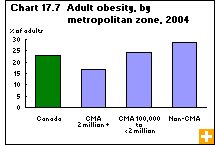Common menu bar links
Obesity less prevalent in large cities
Archived Content
Information identified as archived is provided for reference, research or recordkeeping purposes. It is not subject to the Government of Canada Web Standards and has not been altered or updated since it was archived. Please contact us to request a format other than those available.
Adults who live in large Canadian cities are far less likely to be obese than their counterparts living outside urban centres. Twenty percent of people aged 18 or older living in a census metropolitan area (CMA) in 2004 were obese, compared with 29% of those who lived outside a CMA. The national average is 23%.
The likelihood of being obese is smaller in cities with large populations. In CMAs with a population of at least two million—Toronto, Montréal and Vancouver—only 17% of adults were obese in 2004. By contrast, in CMAs with a population of 100,000 to 2 million, 24% of adults were obese. And in urban centres with populations of 10,000 to 100,000, 30% of adults were obese.
At the national level, this relationship between excess weight and urban/rural residence is not evident among children—except in Alberta. In 2004, Albertans aged 2 to 17 who lived in CMAs were less likely to be overweight or obese than those who lived outside CMAs.
Among adults who do not live in urban centres, those who commute to a large city or even to a smaller urban centre are less likely to be obese. In municipalities where few residents commute to work in an urban centre, the obesity rate is almost twice the national average.
The growing prevalence of obesity among Canadians in recent years is a matter of some concern because obesity increases the higher risk of such health conditions as Type 2 diabetes, cardiovascular disease and high blood pressure. Functional limitations and disabilities are also associated with excess weight.



